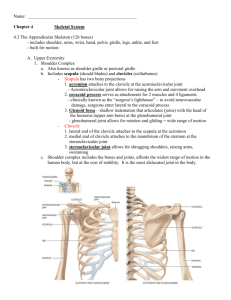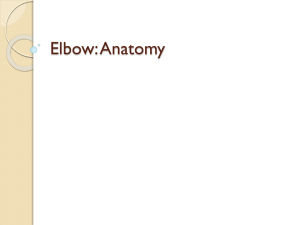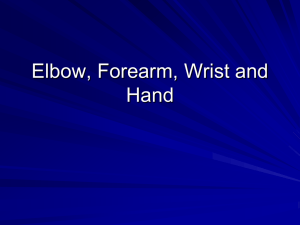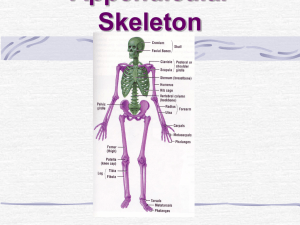antebrachial_growth_deformities
advertisement
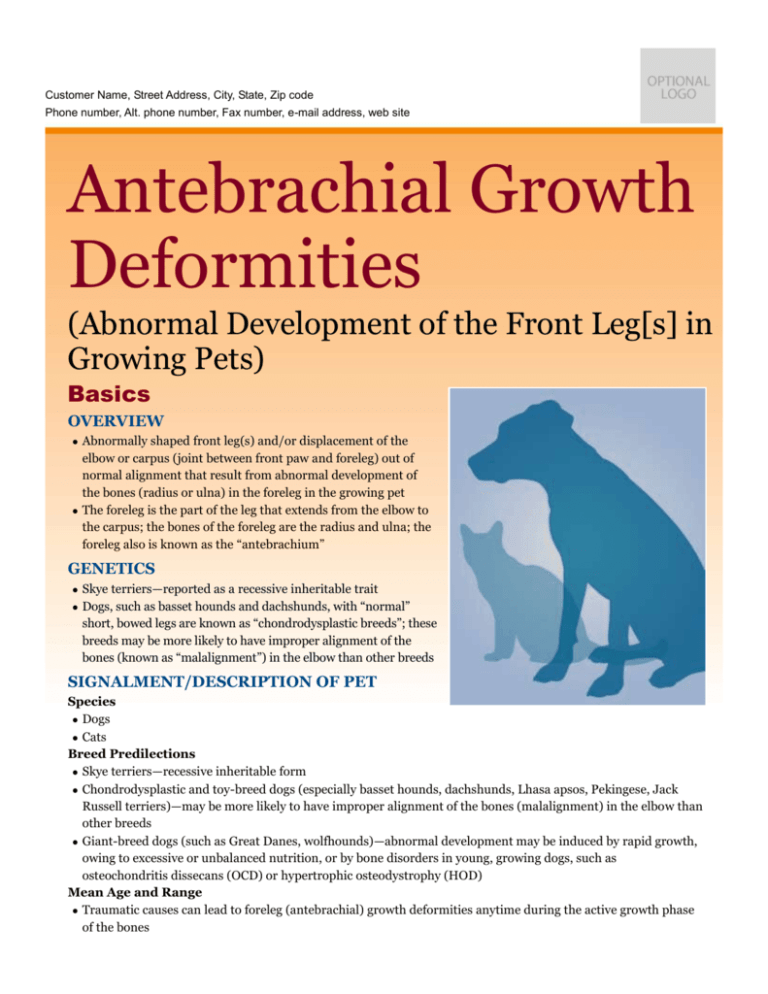
Customer Name, Street Address, City, State, Zip code Phone number, Alt. phone number, Fax number, e-mail address, web site Antebrachial Growth Deformities (Abnormal Development of the Front Leg[s] in Growing Pets) Basics OVERVIEW Abnormally shaped front leg(s) and/or displacement of the elbow or carpus (joint between front paw and foreleg) out of normal alignment that result from abnormal development of the bones (radius or ulna) in the foreleg in the growing pet The foreleg is the part of the leg that extends from the elbow to the carpus; the bones of the foreleg are the radius and ulna; the foreleg also is known as the “antebrachium” GENETICS Skye terriers—reported as a recessive inheritable trait Dogs, such as basset hounds and dachshunds, with “normal” short, bowed legs are known as “chondrodysplastic breeds”; these breeds may be more likely to have improper alignment of the bones (known as “malalignment”) in the elbow than other breeds SIGNALMENT/DESCRIPTION OF PET Species Dogs Cats Breed Predilections Skye terriers—recessive inheritable form Chondrodysplastic and toy-breed dogs (especially basset hounds, dachshunds, Lhasa apsos, Pekingese, Jack Russell terriers)—may be more likely to have improper alignment of the bones (malalignment) in the elbow than other breeds Giant-breed dogs (such as Great Danes, wolfhounds)—abnormal development may be induced by rapid growth, owing to excessive or unbalanced nutrition, or by bone disorders in young, growing dogs, such as osteochondritis dissecans (OCD) or hypertrophic osteodystrophy (HOD) Mean Age and Range Traumatic causes can lead to foreleg (antebrachial) growth deformities anytime during the active growth phase of the bones Abnormal elbow joint alignment actually occurs during growth; however, it may not be recognized until secondary arthritic changes become severe, occasionally at several years of age SIGNS/OBSERVED CHANGES IN THE PET The foreleg is composed of two long bones—the radius and the ulna. The long bones in the body grow in length at specific areas known as “growth plates.” These areas usually continue to produce bone until the bones are fully developed, at which time, no further growth is needed. The growth plates then “close” and become part of the bone. If something happens to the growth plate before the bone is fully developed, it may close prematurely. If only one of the two bones in the foreleg is affected, the other bone continues to grow, causing the foreleg to become deformed. If only one side of a growth plate closes prematurely, the bone will continue to grow on the opposite side, leading to curving of the bone. Signs and physical examination findings are determined by which bone is affected initially and by the location of the premature closure of the growth plate. Longer-limbed dogs—foreleg deformities generally more common Shorter-limbed dogs—tend to develop more severe joint alignment abnormalities Age at the time of premature closure of the bone growth plates affects the relative degree of foreleg deformity and joint alignment abnormalities Trauma to the front leg in a growing pet—progressive limb deformity or lameness 2–4 weeks after injury; owner may not be aware of causative event Developmental elbow alignment abnormalities—slowly progressive onset of lameness in one or both front legs; most apparent after exercise Physical Examination Premature Closure of the Growth Plate of the Radius Affected limb—significantly shorter than the normal opposite front leg Severity of lameness—depends on degree of joint abnormality Complete symmetrical closure of lower growth plate of the radius—may note straight limb with a widened space in the joint between the radius and the carpus (radial carpal joint); may note caudal bow to radius and ulna Asymmetrical closure of medial lower growth plate of the radius—foreleg deformity in which the foreleg is twisted or bent inward toward the center of the body (known as “varus angular deformity”); occasionally inward rotation Closure of lateral lower growth plate of the radius—foreleg deformity in which the foreleg is twisted or bent outward away from the center of the body (known as “valgus angular deformity”); external rotation Closure of upper growth plate of the radius with continued growth of the ulna—deformity of the elbow joint with increased spaces between the bones of the elbow Premature Closure of the Growth Plate of the Lower Ulna (Distal Ulna) Three deformities of the lower (distal) radius may result, leading to the foreleg being twisted or bent to the side (valgus deformity), bowing toward the front of the leg (known as “cranial bowing” or “ curvus deformity”), and external rotation (known as “supination”) Relative shortening of limb length compared to the opposite normally growing limb Partial dislocation (known as “caudolateral subluxation”) of the joint between the radius and the carpus (radial carpal joint) and abnormal motion of the elbow joint due to improper alignment of the bones (malalignment) may occur; causes lameness and painful restriction of joint movement CAUSES Trauma Developmental basis Nutritional basis RISK FACTORS Front leg trauma Excessive dietary supplementation Treatment HEALTH CARE Genetic predisposition—do not breed pets with abnormal growth development of the foreleg Traumatic growth plate damage—not seen at time of injury; revealed 2–4 weeks later Surgical treatment is recommended as soon as possible following diagnosis ACTIVITY Exercise restriction—reduces joint damage; slows arthritic progression DIET Decrease nutritional supplementation in giant-breed dogs—slows rapid grow; may reduce likelihood of abnormal development of foreleg Avoid excess weight—helps control arthritic pain resulting from joint alignment abnormalities and overuse SURGERY Premature growth plate closure of the lower ulna in a pet less than 5–6 months of age (with significant amount of radial growth potential remaining)—treated with a surgical procedure in which a section of the ulna is removed (known as “segmental ulnar ostectomy”) to allow the ulna to lengthen as the radius continues to grow in length, valgus deformities of 25° or less may spontaneously correct and may not require additional surgery; many affected pets, as well as those with more severe deformities, often require a second surgical correction after they have matured Premature growth plate closure of the radius or ulna seen in a mature pet (that is, one with limited or no growth potential) requires surgical deformity correction, joint realignment, or both Deformity correction—may be accomplished with a variety of surgical bone-cutting techniques; the bone then may be stabilized with fixation devices; must correct both rotational and angular deformities; the surgery is performed at the point of greatest curvature Joint alignment abnormalities (particularly affecting the elbow)—must correct to minimize arthritic development (primary cause of lameness); obtain optimal joint alignment using a surgical bone cutting technique or by shortening longer of the two bones Significant limb length discrepancies—surgical bone-cutting technique of the shortened bone, which is then progressively and slowly lengthened (distracted) using an external fixator system (known as “distraction osteogenesis”) to create new bone length Medications Anti-inflammatory drugs—symptomatic treatment of arthritis Nutraceuticals (such as glucosamine) may help minimize cartilage damage and arthritis development; may be anti-inflammatory and may relieve pain Follow-Up Care PATIENT MONITORING Post-operative—depends on surgical treatment Periodic checkups—evaluate arthritic status and anti-inflammatory therapy PREVENTIONS AND AVOIDANCE Selective breeding of susceptible breeds Avoid dietary oversupplementation in rapidly growing giant-breed dogs POSSIBLE COMPLICATIONS Routinely seen with various surgical bone-cutting and fixation techniques (such as infection, lack of healing of the bone [non-union of osteotomy], metal pin [fixator] tract inflammation) EXPECTED COURSE AND PROGNOSIS Generally, best results seen with early diagnosis and surgical treatment—minimizes arthritis Premature ulnar closure—tends to be easier to manage; yields better results Limb lengthening by distraction osteogenesis—requires extensive post-operative management by the veterinarian and owner; high rate of complications Key Points Antebrachial growth deformities are reported to be inherited in Skye terriers and may be inherited in the chondrodysplastic breeds of dogs Damage to the growth plate is not apparent at time of front leg trauma and diagnosis often is made 2–4 weeks following an injury Joint alignment abnormalities and resultant arthritis are primary causes of lameness Early surgical treatment generally leads to a better prognosis Enter notes here Blackwell's Five-Minute Veterinary Consult: Canine and Feline, Fifth Edition, Larry P. Tilley and Francis W.K. Smith, Jr. © 2011 John Wiley & Sons, Inc.




